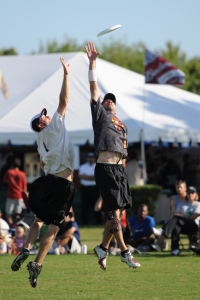Championship Coaches: The Strategies Behind Revolver, Fury, and Nemesis
Anna Levine
Posted: November 13, 2012 04:21 PM
Championship Coaches: The Strategies Behind Revolver, Fury, and Nemesis
It is no secret that many of the teams at the 2012 USA Ultimate Club Championships benefit greatly from coaching. What different leadership styles exist between successful coaches, and how do those differences affect their players?
I followed around three coaches at the helm of some of the most successful elite Ultimate programs out there—Alex Ghesquiere of Revolver, Matty Tsang of Fury, and Ron Kubalanza of Nemesis—and observed their on-field coaching techniques firsthand.
 |
|
 |
|
 |
Alex Ghesquiere
Revolver |
|
Matty Tsang
Fury |
|
Ron Kubalanza
Nemesis |
Here is what I learned:
1. Less is more at game time.
Although each coach acted slightly differently on the sidelines, all three intentionally said very little to their players during the game. This seemed more difficult for some than others. Tsang made restraint look easy: he occasionally walked up and down the field, a mild look of placid concentration on his face as he followed the game. He celebrated cheerfully with the team when they scored and then spent an entire eight seconds addressing his players on the line. Ghesquiere, on the other hand, quickly strode up and down the field—his exceptionally long legs made it easy—and occasionally barked commands at his players in a hoarse voice. He spent his time on the line making singular comments ("We’ve got to stop their up-field backhands and low-release flicks") and calling strings. Like Tsang, Kubalanza said little and followed play loosely—but unlike the Fury coach, you could see the eager nervousness of his players reflected in his eyes. If you looked closely enough, he seemed to be actively restraining himself from jumping onto the field. He spent more time on the line coaching his players and much more time talking strategy to small groups on the sidelines than the other two.
"When you talk to your players on the line, about 20% of what you say gets absorbed," Tsang said. "We do all of our talking the night before." Tsang explained that he talks to Fury about specific teams and strategy before game day so that they know what to expect. "That way, they have more time with the information. They can sleep on it," he said. Both Ghesquiere and Kubalanza heartily agreed with Tsang. "You only have time for one area of focus on the field," said Ghesquiere. Tsang champions simplicity when instructing his players. "We focus on perfecting the simple things. Sure, Fury is good team, but this is the reason why we’re more advanced." In Tsang’s opinion, less is more—on game day and strategy-wise.
Kubalanza admitted with a smile that practicing restraint as a coach isn’t always easy. "There’s certainly an emotional component in coaching for me," he acknowledged. "I still think I’m a player sometimes. I have it pretty much contained, but sometimes I do get frustrated." Great coaches are people too, it seems.
2. Unyielding positivity is key.
As these three top coaches explained, it is the coach’s job to restore confidence when players are feeling low and not playing their best. "I’m an intensely positive coach," said Ghesquiere. "That gives my players energy and keeps them unified." As Kubalanza claimed, "I practice enthusiastic teaching." Tsang explains that when Fury is not doing well, he first acknowledges it—and then immediately moves on to talking about how the team can improve. "I don’t dwell on the bad," he said. When listening to Tsang talk to Fury in a half-time huddle, I could hear how he voiced his commentary and criticism in a positive manner: he began the quick meeting by talking about and celebrating the things the team was doing well, and then made some basic corrections without chastising anyone or putting them down. As Ghesquiere put it, "It is my job to restore everybody’s confidence and expel frustration. You have to expect difficult moments before the game so you’ll be able to plan how to react."
3. Learn to communicate flexibly.
Ghesquiere, Tsang, and Kubalanza are all aware of a very basic truth: all people learn differently. Because of this, these coaches are constantly attempting to determine how to reach their players most clearly. "People learn in all different sorts of ways and hear things differently," Kubalanza explained, citing the Universal Design for Learning as one of his resources. "To address this, I try to present my material in multiple ways. We draw on the white board, we watch videos, and I have other people present things. You can’t guarantee that everyone will hear you, but you have to try." Ghesquiere expressed that knowing how to reach all of your players is one of the most important skills for a coach to have. "My coaching style is based upon how my players hear," he said. "You have to be on the level of your player, and it is the coach’s responsibility to know what that is." For Tsang, figuring out how players like to communicate an ongoing process. "It’s about developing trust, and that takes a while," he said. "Some players that I’m closest to have trouble hearing what I’m saying, some of my most accomplished players. It’s an ongoing, creative process."